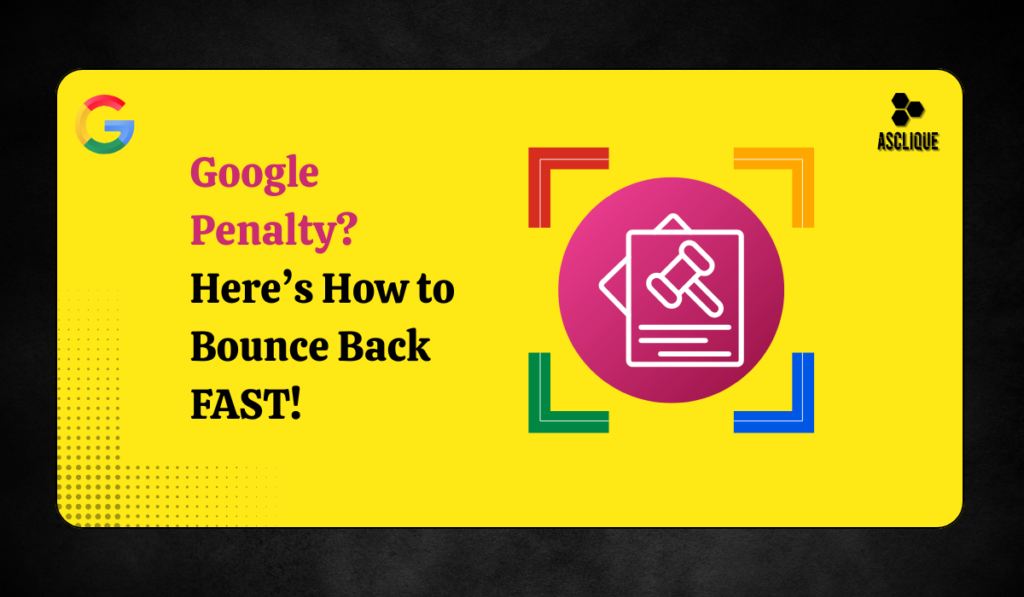Drain in Organic Traffic is every nightmare for a site owner or an online marketer. Imagine your site has simply vanished from the Search Engine Result Pages (SERPs) or your traffic is falling down with no explanation attached! That shall be a Google penalty on your Identity. Now, the good thing is that you can actually help yourself in recovering from Google penalties given you have a proper strategy guided by a step-by-step approach highlighted in this article for entrants into visibility, traffic, and from authority.
What Is a Google Penalty?
Google penalties occur when any site violates the Webmaster Guidelines of Google. Google penalties can be manual, where an actual person reviews the website, or algorithmic, which accidental changes might have triggered, such as Helpful Content or other Core Algorithm updates.
Here is what might happen once your site is penalized:
- Rank losses on keywords
- Heavy losses in traffic
- Deindexation or even removal from the search results
Understanding what caused the penalty is the first step in effective Google penalty recovery.
Types of Google Penalties
Manual Penalty
Resulting from an activities particular Google employee does after examining your site. You will get a manual action notification in Google Search Console under “Manual Actions.” Common reasons are:
- Unnatural backlinks
- Spammy structured data
- Thin content
- Cloaking or sneaky redirects
Algorithmic Penalty
This is triggered automatically by Google ranking algorithms. These are quite hard to spot, as you are not directly notified about them. What will probably happen is:
- Sudden traffic drop
- Loss of keyword rankings
- Page-level or domain-level devaluation
- Some of the bigger or relevant updates which caused these distant penalties are:
- Helpful Content Update
- SpamBrain
- Core Algorithm Updates
How to Diagnose a Google Penalty
Step 1: Check Google Search Console
For manual penalties:
- Go to Search Console → Security & Manual Actions → Manual Actions
- Read the reason and affected URLs
Step 2: Analyze Organic Traffic Trends
Use tools like:
- Google Analytics: Look for sharp, unnatural drops
- Search Console: Check impressions, clicks, and average position
- Ahrefs/SEMrush: Track lost keywords and backlinks
Step 3: Cross-Reference with Algorithm Update Dates
Use websites like:
If your traffic drop aligns with an update, you may need algorithmic Google penalty recovery.
Google Penalty Recovery: Step-by-Step Process
Step 1: Identify the Root Cause
Once the whole site has been audited, Google recovery begins. Look for:
Common Issues:
- Thin or duplicate content
- Keyword stuffing
- Cloaked pages or redirects
- Unnatural inbound links
- AI-generated content with no editorial oversight
- Non-mobile-friendly design or slow-loading
Best tools to use:
- Screaming Frog: Crawl and analyze technical issues
- Ahrefs/SEMrush: Audit backlinks and anchor text
- SurferSEO or Clearscope: Compare content quality against competitors
Step 2: Cleanup and Fixing
Depending on the types of penalties, the main remediation procedures during a Google penalty recovery will be:
Content Penalty:
- Delete or enhance thin and duplicate pages
- Add original, useful, user-first content
- Remove doorway pages and low-value affiliate content
- Follow EEAT (Experience, Expertise, Authoritativeness, Trustworthiness)
Link Penalty:
- Audit all backlinks
- Find spammy, paid, or irrelevant links
- Disavow harmful links using the Google Disavow Tool
- Ask webmasters to remove the links, if possible
Technical Penalty:
- Improve Core Web Vitals (LCP, CLS, FID)
- Fix crawl errors, redirect loops, broken redirects, and broken links
- Ensure mobile-first design and fast load speeds
- Use HTTPS and secure your site
Step 3: Submit the Reconsideration Request (Manual Penalties)
In the case of a manual penalty:
- Log into Google Search Console
- Go to Manual Actions → Request Review
Write a clear, honest message that includes:
- What the issue was
- Steps taken for correction
- Evidence of cleanup (screenshots, examples)
This step is critical in Google penalty recovery from manual actions.
Note: It can take 2–6 weeks for Google to respond. Rejection is possible if your cleanup isn’t thorough.
Step 4: Track and Rebuild Trust
Even after resolving the issue, full Google penalty recovery requires rebuilding your site’s authority and trust.
Continuing Things To Recover:
- Regularly publishing high-quality content
- Acquiring natural backlinks via outreach, PR, or partnerships
- Building trust in your brand through author bios, transparency about the company and building trust signals
- Establish topical authority, don’t chase keywords
How Long Does Google Penalty Recovery Take?
Recovery time depends on:
- Type of penalty (manual vs algorithmic)
- Severity of issues
- Speed of cleanup and content updates
Estimated Timelines:
- Manual penalty: 2–8 weeks (after review request)
- Algorithmic penalty: 1–3 months (until the next core update)
- Full recovery: Up to 6 months for competitive niches
Patience and persistence are key to successful Google penalty recovery
How to Prevent Future Penalties
Proactive steps can help you avoid future penalties altogether:
- Keep up to date with Google algorithm updates
- Conduct SEO audits regularly (every 3-6 months)
- Avoid black-hat strategies (keywords stuffing, PBNs, cloaking)
- Ensure a clean backlink profile
- Use AI in an ethical manner—be sure to edit and humanize machine generated content
- Deliver value to the user—not just for the purpose of ranking.
Preventing issues is often easier than undergoing Google penalty recovery again.
Also Read: How to Redirect HTTP to HTTPS: A Step-by-Step Guide for SEO and Website Security
Conclusion
A penalty could feel like you have lost everything—but a penalty should also be treated as an opportunity. The penalty recovery process forces you to build a better and more credible website that both users and search engines will appreciate. If you follow the steps to rectify violations, defence your SEO practices, you should be able to recover, and not just recover but prosper after a penalty.
FAQ’s
What is a Google penalty?
A Google penalty occurs when a site violates Google’s Webmaster Guidelines which results in a drop in rankings either manually or algorithmically.
How do I know if my site has a Google penalty?
You can check Google Search Console for any manual actions, or check for any sudden traffic drops or ranking losses.
How long does it take to recover from a Google penalty?
Recovery from a penalty may take as little as a few weeks (manual penalties) or several months (algorithmic penalties).
Will I be able to recover from a Google penalty on my own?
Yes, if you do your due diligence and conduct audits and fixes. More complex penalties will require professional assistance.
How do I avoid getting another Google penalty?
Follow Google’s guidelines, don’t use spammy tactics, and focus on quality content and clean backlinks.

